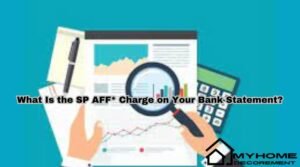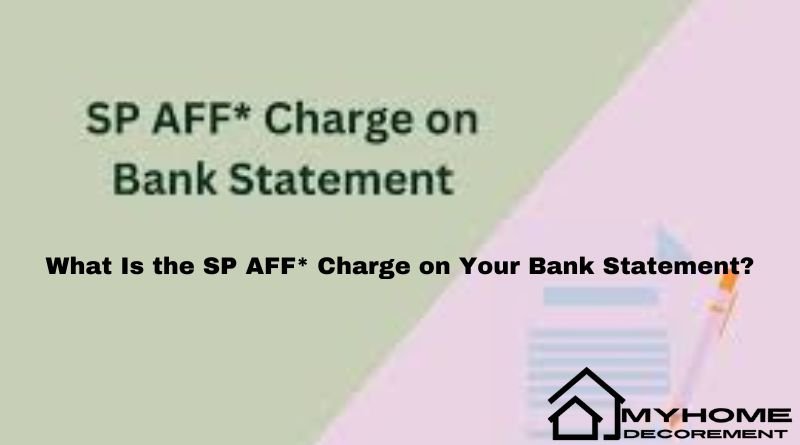If you’ve recently reviewed your bank statement and found a charge labeled “SP AFF* San Francisco CA,” you might be wondering what this mysterious entry signifies. This guide will delve into the possible meanings of this charge, its origins, and how to address any concerns or disputes you may have.
Understanding the SP AFF* Charge
The SP AFF* charge appearing on your bank statement typically indicates a transaction processed through a third-party payment platform or service. This charge is often associated with subscription services, online purchases, or other transactions that require a secure and reliable payment processor. “SP AFF*” stands for Service Provider Affiliate, a tag used by various companies to track their transactions and payments. The “San Francisco CA” part of the description usually points to the location of the service provider’s headquarters or their billing operations.
Common Sources of SP AFF* Charges
Subscription Services
Many online platforms and subscription services use third-party payment processors to handle recurring payments. If you have recently signed up for a subscription, such as a streaming service, digital magazine, or a software subscription, the SP AFF* charge could be from one of these services. Companies often use abbreviations or cryptic descriptions to maintain confidentiality or streamline their billing processes.
Online Purchases
E-commerce sites and online marketplaces frequently employ third-party payment processors to manage transactions. If you’ve purchased products from an online retailer based in or operating out of San Francisco, the charge might appear under SP AFF* San Francisco CA. These transactions can range from one-time purchases to recurring orders, such as monthly delivery services or membership fees.
Trial Offers and Promotional Deals
Promotional offers and free trials often require you to provide payment information upfront. If you forget to cancel before the trial period ends, you may start seeing charges on your account. These charges are often processed through third-party services, resulting in an SP AFF* entry on your statement.
Identifying Legitimate SP AFF* Charges
Reviewing Recent Transactions
To identify the source of an SP AFF* charge, start by reviewing your recent transactions and purchases. Check for any subscriptions, online orders, or trial services you might have signed up for. Compare the transaction dates and amounts with those listed on your bank statement. This can help you pinpoint the exact source of the charge.
Contacting Customer Service
If you’re unable to recognize the charge, contacting the customer service department of your bank or credit card issuer is a prudent step. They can provide additional information about the transaction, such as the merchant’s full name and contact details. This information can help you trace the origin of the charge and determine its legitimacy.
Checking Email and Account Notifications
Many services send email notifications or account alerts for new charges or upcoming payments. Search your email inbox and spam folder for any correspondence that matches the transaction date and amount. Additionally, log into your online accounts for any subscription services to review billing statements and payment histories.
Handling Unauthorized SP AFF* Charges
Reporting Fraudulent Transactions
If you determine that the SP AFF* charge is unauthorized or fraudulent, it’s crucial to act quickly. Contact your bank or credit card issuer immediately to report the charge and initiate a dispute. Most financial institutions have fraud protection policies that can help you recover your funds. They may also issue a new card to prevent further unauthorized charges.
Monitoring Your Accounts

After reporting a fraudulent charge, closely monitor your bank and credit card accounts for any additional suspicious activity. Regularly reviewing your statements and setting up account alerts can help you detect and address unauthorized transactions promptly. Keeping a vigilant eye on your accounts is essential to safeguarding your financial information.
Preventing Future Unrecognized Charges
Managing Subscriptions and Services
One of the best ways to prevent unrecognized charges is by managing your subscriptions and services effectively. Keep a record of all active subscriptions, including start dates, renewal dates, and cancellation policies. Setting reminders for trial period end dates can help you avoid unexpected charges. Many subscription services also offer the option to pause or cancel memberships online, providing an easy way to manage your accounts.
Using Virtual Credit Cards
Virtual credit cards, or single-use credit card numbers, are a useful tool for online purchases and subscriptions. These cards are linked to your main account but have unique numbers that can be used for specific transactions. They provide an added layer of security by preventing merchants from charging your primary account directly. If you encounter an unauthorized charge, you can easily deactivate the virtual card without affecting your main account.
Regularly Reviewing Bank Statements
Make it a habit to regularly review your bank and credit card statements. This practice can help you quickly identify any unfamiliar or unauthorized charges. Setting aside time each month to go through your statements ensures that you stay on top of your finances and can address any discrepancies promptly.
Conclusion
The appearance of an SP AFF* charge on your bank statement can be perplexing, but understanding its potential origins and how to address it can help ease your concerns. By reviewing recent transactions, contacting customer service, and monitoring your accounts, you can determine whether the charge is legitimate or unauthorized. Taking proactive steps to manage your subscriptions, using virtual credit cards, and regularly reviewing your statements can prevent future unrecognized charges and protect your financial information. If you encounter an SP AFF* charge that you cannot identify, don’t hesitate to reach out to your bank or credit card issuer for assistance.
Read also: check



